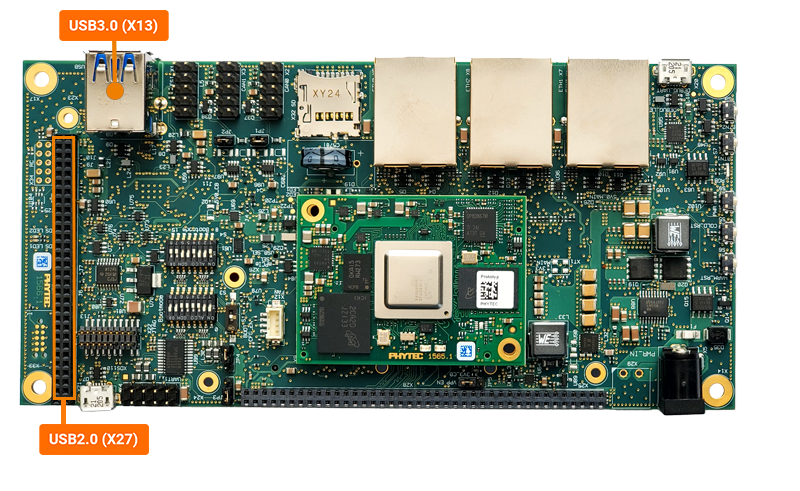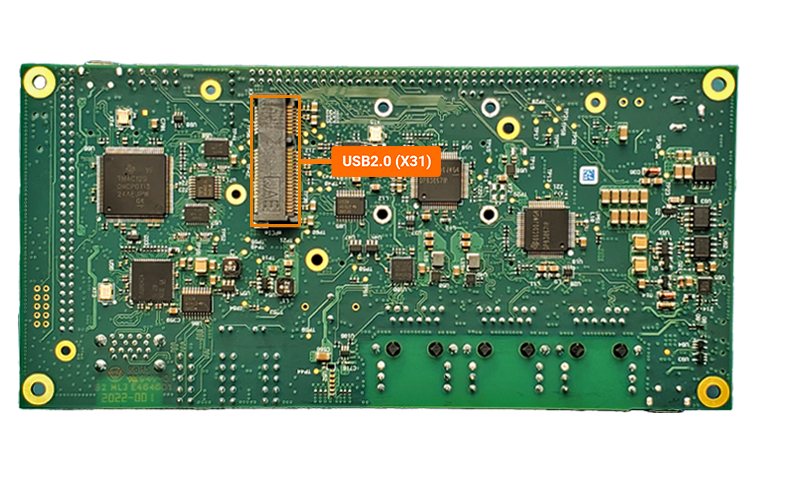USB
The Universal Serial Bus (USB) can be utilized for many functions on the development kit, including external media. The phyCORE-AM64x System-on-Module (SOM) provides one USB 3.1 Gen 1 Dual-Role Device (DRD) Subsystem (USB0) which can be utilized as a USB 2.0 port with OTG functionality or as a USB 3.1 port with USB 3.1 Gen 1 and xHCI 1.1 specification. The full pinout of the USB 3.1 controller includes the signaling for both USB 3.1 and USB 2.0. This means that USB0 can be used as either a USB 3.1 port or a USB 2.0 port.
This guide will show you how to use the USB Host capabilities featured on the phyCORE-AM64x development kit. To learn more information about the phyCORE-AM64x USB interface, please see section 7.8 in the Hardware Manual.
The USB0 interface uses a USB HUB to split the bus to 4x locations.
Type |
Qty |
Header Location |
Speed |
Bus |
|---|---|---|---|---|
USB A Double Stacked |
2 |
X13 |
3.1 |
002 |
Mini PCIe |
1 |
X31 |
2.0 |
001 |
Pin Header |
1 |
X27 (Pin 21, 22, 37, 39) |
2.0 |
001 |


Warning
The USB super speed signals are muxed between the miniPCIe interface and the USB HUB. Enabling miniPCIe (done via device tree overlay) will disable USB3.0 speeds at the stacked type-A USB connector but USB2.0 speeds will still be available.
Requirements
Development Kit Setup
First, ‘poweroff’ the development kit.
Target (Linux)poweroff
Power on the development kit and stop in U-Boot when prompted.
Enable the device tree overlay.
setenv overlays k3-am64-phyboard-electra-rdk-pcie-usb2.dtbo
boot
Note
For more information about overlays see chapter Configuring the Bootloader.
Verifying USB Interface
With the phyCORE-AM64x development kit booted into Linux, see that there are 4 USB devices. There should be 2 devices on each bus.
Target (Linux)lsusb
Expected OutputBus 002 Device 001: ID 1d6b:0003 Linux 6.1.33-bsp-yocto-ampliphy-am64x-pd23.2.0 xhci-hcd xHCI Host Controller Bus 001 Device 002: ID 0451:8242 Bus 001 Device 001: ID 1d6b:0002 Linux 6.1.33-bsp-yocto-ampliphy-am64x-pd23.2.0 xhci-hcd xHCI Host Controller
Insert a USB3.0 storage device into the top connector on X13. You should see something like the following on the serial console:
Expected Outputroot@phyboard-electra-am64xx-2:~# [ 30.428000] usb 1-1.1: new high-speed USB device number 4 using xhci-hcd [ 30.532866] usb 1-1.1: New USB device found, idVendor=0781, idProduct=5591, bcdDevice= 1.00 [ 30.541258] usb 1-1.1: New USB device strings: Mfr=1, Product=2, SerialNumber=3 [ 30.548583] usb 1-1.1: Product: SanDisk 3.2Gen1 [ 30.553247] usb 1-1.1: Manufacturer: USB [ 30.557275] usb 1-1.1: SerialNumber: 0401a83fbd697e437712b826697973aaaf57d1c75e9691ad879dfe7934b8a81bea020000000000000000000037ac13c5ff935d18915581076e2cc649 [ 30.573038] usb-storage 1-1.1:1.0: USB Mass Storage device detected [ 30.580206] scsi host0: usb-storage 1-1.1:1.0 [ 31.609115] scsi 0:0:0:0: Direct-Access USB SanDisk 3.2Gen1 1.00 PQ: 0 ANSI: 6 [ 31.622632] sd 0:0:0:0: [sda] 30031872 512-byte logical blocks: (15.4 GB/14.3 GiB) [ 31.636317] sd 0:0:0:0: [sda] Write Protect is off [ 31.641991] sd 0:0:0:0: [sda] Write cache: disabled, read cache: enabled, doesn't support DPO or FUA [ 31.664047] sd 0:0:0:0: [sda] Attached SCSI removable disk
Re-run the ‘lsusb’ command and verify that the USB drive connected to bus 002.
Target (Linux)lsusb
Expected Outputroot@phyboard-electra-am64xx-2:~# lsusb Bus 002 Device 001: ID 1d6b:0003 Linux 6.1.33-bsp-yocto-ampliphy-am64x-pd23.2.0 xhci-hcd xHCI Host Controller Bus 001 Device 004: ID 0781:5591 USB SanDisk 3.2Gen1 Bus 001 Device 002: ID 0451:8242 Bus 001 Device 001: ID 1d6b:0002 Linux 6.1.33-bsp-yocto-ampliphy-am64x-pd23.2.0 xhci-hcd xHCI Host Controller
To list more information about the USB device and buses on the development kit use the following command.
This command will output a good chunk of information. This guide will only show a snippet of the expected output for the USB drive that was just connected.
Target (Linux)lsusb -v -s 001:004
Note
“001” refers to bus 001 and “004” refers to the device number, both of these can be found in the lsusb command.
Bus 001 Device 004: ID 0781:5591 USB SanDisk 3.2Gen1
Device Descriptor:
bLength 18
bDescriptorType 1
bcdUSB 2.10
bDeviceClass 0
bDeviceSubClass 0
bDeviceProtocol 0
bMaxPacketSize0 64
idVendor 0x0781
idProduct 0x5591
bcdDevice 1.00
iManufacturer 1 USB
iProduct 2 SanDisk 3.2Gen1
iSerial 3 0401a83fbd697e437712b826697973aaaf57d1c75e9691ad879dfe7934b8a81bea020000000000000000000037ac13c5ff935d18915581076e2cc649
bNumConfigurations 1
Configuration Descriptor:
bLength 9
bDescriptorType 2
wTotalLength 0x0020
bNumInterfaces 1
bConfigurationValue 1
iConfiguration 0
bmAttributes 0x80
(Bus Powered)
..continues..
The speed of the USB device can be determined with either the lsusb -v from above or by reading the device’s “speed”
Target (Linux)cat /sys/bus/usb/devices/usb2/speed
Expected Outputroot@phyboard-electra-am64xx-2:~# cat /sys/bus/usb/devices/usb2/speed 5000
Note
USB3.0 has transmission speeds up to 5000 Mbit/s, also known as “super speed”. USB2.0 has transmission speeds up to 480Mbit/s, also known as “full speed”.
Mounting USB Stroage Devices
Verify that a device directory was established for the USB drive.
Run the following command to confirm the USB device name.
Target (Linux)ls /dev/sd*
Expected Outputroot@phyboard-electra-am64xx-2:~# ls /dev/sd* /dev/sda
Remove the USB drive.
Re-run the ‘ls /dev/sd’ command to confirm the device name.
Expected Outputroot@phyboard-electra-am64xx-2:~# ls /dev/sd* /dev/sda
Re-insert the USB drive to the top connector of X13.
Note
In this example the device name for the USB drive is “sda”.
Make a directory for mounting the USB device.
Target (Linux)mkdir ~/usb_sda
Format file type.
Target (Linux)mkfs.vfat /dev/sda
Mount the USB device to the directory.
Target (Linux)mount /dev/sda ~/usb_sda/
See what media is on the USB drive.
Target (Linux)ls ~/usb_sda/
Write to the USB Host Device
Generate a random 10 MB file to test transferring data from the storage device.
Target (Linux)dd if=/dev/urandom of=test.file count=10 bs=1M
Expected Outputroot@phyboard-electra-am64xx-2:~# dd if=/dev/urandom of=test.file count=10 bs=1M 10+0 records in 10+0 records out 10485760 bytes (10 MB, 10 MiB) copied, 0.216022 s, 48.5 MB/s
Copy the file to your storage device.
cp test.file ~/usb_sda/ && sync
Read from the USB Host Device
Copy the test file we previously created during the write process back to the host:
Target (Linux)cp ~/usb_sda/test.file readback-usb.file && sync
We can double check that the file was successfully copied to and from the USB device by checking the md5sum of the file:
Target (Linux)md5sum test.file readback-usb.file
Expected Outputroot@phyboard-electra-am64xx-2:~# md5sum test.file readback-usb.file d3aa3ee1db746d6f7fb66c9b42f4ea6b test.file d3aa3ee1db746d6f7fb66c9b42f4ea6b readback-usb.file
Unmounting the Drive
Warning
Make sure the drive is unmounted prior to physically disconnecting the device. Failure to do so may result in loss of data and corruption of files
umount ~/usb_sda/
umount /dev/sda